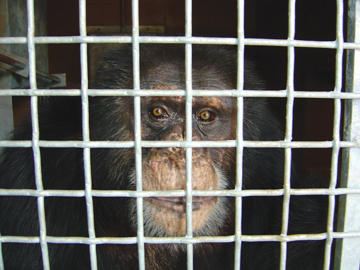June/July
2007
Chimpanzee
Travels
The Journey of the OSU Primates
|
 |
Darrell at PPI. Photo
courtesy of PETA |
Nine chimpanzees—Sarah, Keeli, Ivy, Sheba, Darrell, Harper, Emma,
Bobby and Kermit—and three capuchin monkeys—Ulysses, Rain
and Jane—were all subjects in animal cognition research at Ohio
State University under Sally Boysen. When the university decided to stop
funding this research, they made arrangements to send the animals to
Primarily Primates Inc. (PPI) in San Antonio, TX. OSU agreed to pay PPI
over $200,000 for new housing plus an endowment for their care. But when
the chimpanzees arrived in March 2006, their new quarters were not yet
built. Kermit died during transport, and Bobby passed away shortly after
his arrival. Jane escaped from her PPI enclosure and is presumed dead.
Both Boysen and PETA did not feel PPI could adequately care for these animals.
In May of 2006, a lawsuit funded by PETA was filed on behalf of the OSU primates.
The Bexar County district judge hearing the case appointed a master in chancery
to oversee the sanctuary, who recommended the OSU chimps be transferred to Chimp
Haven in Louisiana, the first federally subsidized chimpanzee retirement facility.
This lawsuit was eventually dropped in September 2006.
In November 2006, however, under the temporary receivership, the seven OSU chimpanzees
were transferred to Chimp Haven. Primatologist Jane Goodall supported this move
in a letter dated August 25, 2006. On the day of the transfer sanctuary founder
Wally Swett was reported to have threatened one of the volunteers with a rifle.
Friends of Animals objected to the decision to transfer the OSU chimps since
Chimp Haven is partially funded by the Chimpanzee Health Improvement Maintenance
Protection (CHIMP) Act. The act was signed into law at the end of the Clinton
administration to retire the surplus chimpanzees from federally-funded research
laboratories, but includes a clause that they could be returned to research if
a need arises. To date no retired chimpanzee has been recalled, but FoA’s
legal director Lee Hall contends Chimp Haven’s mission is “basically
storage for the National Institutes of Health.”
PETA’s attorney Leana Stormont disagrees with that assessment, noting Chimp
Haven has two components. The first is a private sanctuary and the second is
a contract pursuant to the CHIMP Act to house the federally retired chimpanzees.
At Chimp Haven, the OSU chimps would be privately retired. “No animal that
is privately retired is ever subject to recall,” Stormont insists.
But Hall questions why animal advocacy organizations would support Chimp Haven,
a “satellite of an institution of use” instead of a sanctuary like
PPI. “Ask Darrell,” Stormont suggests. At PPI, Darrell, one of the
OSU chimpanzees, was housed alone in one of the dark, cramped and barren chimpanzee
night cages, without access to the outside. Swett claims he was advised that
Darrell was an aggressive chimp and shouldn’t be paired with Keeli. He
says Darrell “was fine and happy, just temporarily alone,” until
construction on their new enclosures was complete.
“He was locked in there by himself for eight months!” court-appointed
receiver Lee Theisen-Watt exclaims. “The enclosure that he was in, the
temperature [at one point] was measured to be 107 degrees…They didn’t
go over and visit with him and talk to him. They threw him chow and left because
they had a lot of work to do. It was a horrible existence.” Theisen-Watt
contends how cramped the conditions were for the OSU chimps at PPI, and the burden
it placed on the other chimpanzees.
Stormont adds, “After Kermit and Bobby died, two of the females didn’t
really have anyone to look out for them. The two teenage chimps really ran roughshod
over them. And they both almost starved to death because their choice every day
was try to get a biscuit and risk getting beat up or go hungry.”
Swett feels the weight-loss was “nothing serious, nothing unusual with
the move.” But Theisen-Watt counters, “those conditions are not conducive
to a happy well adjusted environment. For them to wake up at Chimp Haven, being
reintroduced to each other on an island with indoor and outside facilities, being
able to climb trees. It’s night and day.”
Since the receiver only had the authority to temporarily transfer these animals,
PPI still holds the title on the OSU chimpanzees. The April 2007 settlement agreement
between the Office of the Attorney General and PPI outlines that the new restructured
board of PPI should use its best efforts to finish the enclosures for the OSU
chimpanzees as soon as possible, but no later than October 23, 2007. The OAG
will facilitate the return of the seven chimpanzees, with the transport costs
born by PPI.
If these chimpanzees return to PPI, they will have traveled from Ohio to Texas,
to Louisiana and back to Texas in less than the course of two years. Trained
in math, they might be able to calculate the miles of this journey, but the toll
is harder to quantify—S.I.
| |
|
|
| © STEALTH TECHNOLOGIES INC. |
|
|

